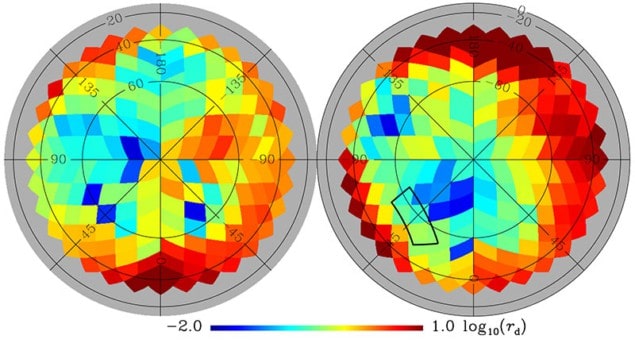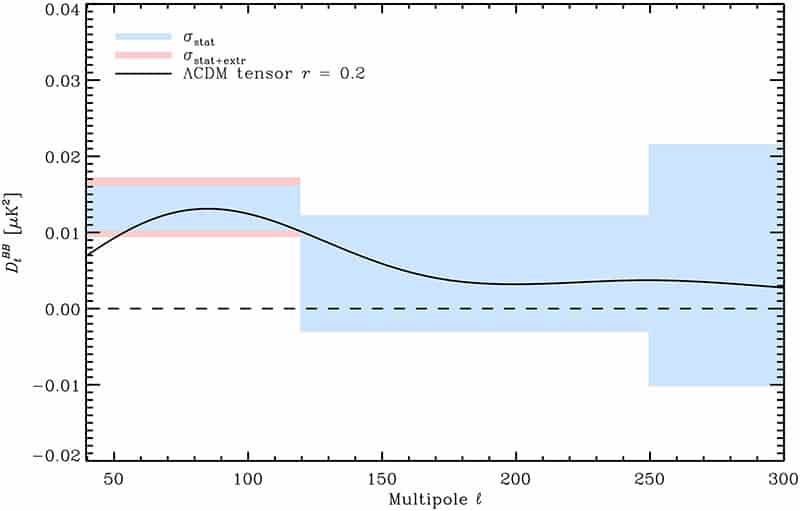
Astronomers working on the Background Imaging of Cosmic Extragalactic Polarization (BICEP2) telescope at the South Pole hit the headlines earlier this year when they claimed to have seen the first evidence for the primordial “B-mode” polarization of the cosmic microwave background (CMB). But a new analysis of polarized dust emission in our galaxy, carried out by the Planck collaboration, has shown that the part of the sky observed by BICEP2 has much more dust than originally anticipated.
The B-modes observed by the BICEP telescope are therefore most likely to be “local” galactic contamination rather than an imprint left behind by the rapid “inflation” of the early universe – the extremely rapid expansion that cosmologists believe our universe underwent a mere 10–35 s after the Big Bang. While the new analysis does not completely rule out BICEP2’s original claim just yet, it does establish that the dust emission is nearly as big as the entire BICEP2 signal.
Extraordinary claims
The BICEP2 team initially claimed its measurement was at a statistical certainty of 7σ – well above the 5σ gold standard for a discovery in physics. Many scientists hailed the result as the initial proof for inflation, but not everyone was convinced and other researchers soon pointed out that the BICEP2 team might have seriously underestimated the contribution of dust in our galaxy in their signal.
A foreground, such as the dust that BICEP2 may have detected, could consist of any emissions that could be confused with primordial CMB photons since they were last scattered at the “epoch of recombination”, when neutral atoms first formed and the decoupling of matter and radiation allowed photons to travel freely across the universe. When carrying out large-scale surveys of the CMB, researchers need to account for two important sources of electromagnetic emissions in our galaxy – synchrotron radiation from electrons moving in the galactic magnetic field and polarized emission from dust – to ensure that they do not mimic the signal they are searching for.
While the BICEP2 researchers claimed to have ruled out known contamination from synchrotron radiation and dust at a statistical significance of about 2σ by cross-correlating what they saw with preliminary results from the Planck data available last year, we now know that their estimate was too low. Another criticism is that the method the team used to check its signal against that of the dust was not robust. Furthermore, BICEP2 only makes its measurements at a single frequency of 150 GHz.
Dusty doubts
Neil Turok, director of the Perimeter Institute of Theoretical Physics in Canada, who has been a vocal critic of the BICEP2 result from the start, says that the experiment itself “has many limitations, the main one being that it is only at one frequency”. BICEP2 could not therefore check if its signal is also seen at other frequencies, which it would have to be if it were a truly cosmological effect. Indeed, Turok says that BICEP2’s measurements in themselves were sound; it was the collaboration’s claims of having found the smoking gun for inflation that were excessive and unnecessary.
Peter Coles, an astrophysicist at the University of Sussex in the UK, who has also been sceptical of the BICEP2 findings, is unsurprised by the new Planck analysis. “There’s been quite a lot of circumstantial evidence accumulating that the polarized emission from galactic dust is more significant and more complicated than cosmologists had expected,” he says. “My feeling, though, is galactic astronomers always felt this was going to be the case.”
Following BICEP2’s announcement in March, Subir Sarkar – a particle theorist at the University of Oxford and the Niels Bohr Institute in Copenhagen – claimed to have found evidence of emissions from magnetized dust in local structures of dust in our galaxy. These “radio loops” could generate a previously unknown polarized signal, casting further doubt on the BICEP2 finding. According to Sarkar and colleagues, this previously unrecognised foreground at microwave frequencies is present at high galactic latitudes and could easily be misinterpreted as a B-mode polarization signal.
Jumping through loops
In light of the new Planck data, Sarkar is convinced that a loop structure, which crosses the BICEP2 observation region, may be the main culprit. “Planck data have confirmed that there is indeed such an emission from the Milky Way. This radiation is polarized and can plausibly account for the high polarization fraction of 20% required in the BICEP2 observation region,” says Sarkar. He adds that further detailed cross-correlation studies of Planck and BICEP2 data will be required for a definitive answer.
The Planck and BICEP2 collaborations are now joining forces to examine all of their data, to suss out any possible signal that may have originated from primordial gravitational waves. Their joint results should be available by the end of the year and should set the debate straight on BICEP2’s observation.
“A joint BICEP2/Planck analysis will have the benefit of complementarity between Planck’s much better frequency coverage and all-sky mapping capability versus BICEP2’s higher sensitivity, so it remains possible that a primordial gravitational wave signal can be extracted from the data through this combination,“ says Coles. “It will be difficult, though, and if I had to bet I’d probably guess that it will end with no detection.”
“To get the required sensitivity, sky coverage and frequency range will probably require a dedicated satellite mission,” says Coles and currently proposed missions such as LiteBIRD and COrE may fit the bill. However, Planck’s current observations also found certain patches of the sky that are cleaner and more devoid of dust than that studied by BICEP2. “So perhaps the existing ground-based polarization experiments, such as the South Pole Telescope or Atacama Cosmology Telescope, might have a chance if they are deployed to those regions,” says Coles. Observations made by these experiments, in conjunction with Planck, will hopefully settle the debate on gravitational waves within the next three to five years.
A pre-print of the new Planck result is available on the arXiv server.




